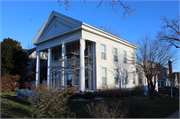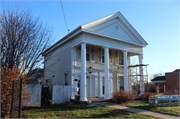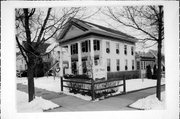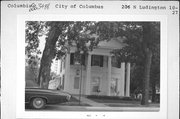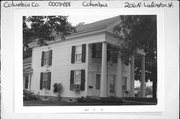Property Record
206 N LUDINGTON ST
Architecture and History Inventory
| Historic Name: | DAVID D. KELSEY HOUSE |
|---|---|
| Other Name: | |
| Contributing: | |
| Reference Number: | 3488 |
| Location (Address): | 206 N LUDINGTON ST |
|---|---|
| County: | Columbia |
| City: | Columbus |
| Township/Village: | |
| Unincorporated Community: | |
| Town: | |
| Range: | |
| Direction: | |
| Section: | |
| Quarter Section: | |
| Quarter/Quarter Section: |
| Year Built: | 1853 |
|---|---|
| Additions: | |
| Survey Date: | 19962021 |
| Historic Use: | house |
| Architectural Style: | Greek Revival |
| Structural System: | |
| Wall Material: | Aluminum/Vinyl Siding |
| Architect: | |
| Other Buildings On Site: | |
| Demolished?: | No |
| Demolished Date: |
| National/State Register Listing Name: | Not listed |
|---|---|
| National Register Listing Date: | |
| State Register Listing Date: |
| Additional Information: | A 'site file' exists for this property. It contains additional information such as correspondence, newspaper clippings, or historical information. It is a public record and may be viewed in person at the Wisconsin Historical Society, Division of Historic Preservation. Kelsey was a Columbus blacksmith and an early settler whose shop was a block away on Water Street. Blacksmith David Kelsey trumpeted his prosperity by commissioning this clapboard house, fashioned in the form of a Greek temple. Fluted Doric columns support a broad triangular pediment. Underneath, miniature pediments supported by pilasters surmount the entry door and first-floor windows. Full-height pilasters frame the front façade, completing the classical composition. Classically inspired architecture has long appealed to Americans, many of whom associated the American republic with the ancient Greek roots of democracy. The Greek Revival style became immensely popular between 1830 and 1860, thanks in part to the groundswell of nationalistic sentiment unleashed by the War of 1812, Greece’s own war for independence in the 1820s, and the broadening of democracy under President Andrew Jackson. Pattern books for carpenters helped spread the Greek Revival, so that it came to be known as the “National style.” This excellent temple-front Greek Revival style house was originally clad in clapboards but it has been recently completely resided in vinyl siding complete with vinyl wood shingles in the main tympanum. 2021 - The David D. Kelsey House was constructed c.1853. It is a two-story Greek Revival style house with a rectangular footprint, concrete foundation, vinyl siding, and a front pediment roof supported by four Doric columns creating a full width porch. The front pediment has a wide band of trim, is clad in shingles, and has a hexagonal louvered opening. The entrance and first floor windows have pediments and pilasters. The modern replacement door has a single sidelight on the left side. At each end of the façade is a full-height pilaster. Windows are four-over-four modern replacements. At the rear of the house is a one-story addition. |
|---|---|
| Bibliographic References: | COLUMBUS HISTORIC ARCHITECTURE TOURS, COLUMBUS HISTORIC LANDMARKS AND PRESERVATION COMMISSION, 1994. Stare, Frederick A. The Story of Columbus. Installment No. 115 (pp. 173-174). Buildings of Wisconsin manuscript. Columbus Historic Architecture Tours, undated. |
| Wisconsin Architecture and History Inventory, State Historic Preservation Office, Wisconsin Historical Society, Madison, Wisconsin |

